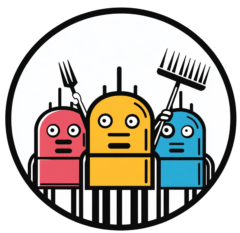In twenty years, dinner might look a lot different than it does today. Picture this: instead of a frozen, microwaved meal, you’re enjoying a plate of seasonal, locally sourced food – picked, foraged, or raised by robots. It’s a culinary revolution as transformative as the agricultural and industrial revolutions that came before, merging tradition with cutting-edge technology.
Imagine a world where pigs are fed entirely on organic waste from households and businesses, and ruminants graze only on marginal lands unsuitable for crops. This sustainable system could provide around 35-45 kg of meat per person annually – far less than current consumption in many countries but enough to make meat a treat again, rather than a staple. Poultry could complement this, feeding on insects, scraps, and crop residues, while maintaining animal welfare and reducing environmental impact.
This system offers a palatable alternative to some of the stricter vegan proposals, keeping meat in the diet but produced in ways that are better for the planet than almond milk and avocado oil. It’s a step towards reconciling traditional dietary preferences with environmental responsibility.
Robots could not only transform farming but also facilitate hyper-local food systems. Picture every family owning a small piece of land where robots handle the daily work – planting, weeding, and harvesting – allowing people to live from their produce without being expert farmers. Automation could also enable local food swaps: algorithms would match surplus apples from one farm with eggs from another, and drones or small autonomous vehicles would handle the logistics.
This decentralised model would bring back the charm of local cheeses, unique to every farm, but with the added benefit of modern recipe sharing and automated quality control. Seasonal eating, once a necessity, could become an adventure again, with each meal reflecting the time of year and the quirks of the local environment.
Foraging robots could add a touch of the wild to our diets. Equipped with AI to identify edible plants and mushrooms, they could sustainably harvest nettles, wild garlic, berries, and even nuts, delivering them straight to your kitchen. These robots could help us rediscover the flavours of our natural surroundings while ensuring we harvest responsibly, preserving biodiversity.
For those who aren’t keen on cooking, a robot chef could take care of everything, curating meals based on local, seasonal ingredients. It could adapt recipes to your preferences, gradually introducing more plant-based dishes and making the transition to a diet with less meat seamless and enjoyable. For those who love to cook, the robot could switch to sous-chef mode, prepping and tidying while you enjoy the creative process.
This vision isn’t just about convenience; it’s about resilience. A decentralised, semi-automated food system would be far less vulnerable to global supply chain disruptions. Built-in insurance mechanisms – like surplus reserves or local redistribution networks – could protect against crop failures, ensuring no one goes without.
Of course, every revolution comes with its cultural quirks. Today’s young vegans, who are at the forefront of the plant-based movement, may one day become the pensioners who grumble about wanting their imported almond milk and avocado toast. Meanwhile, their grandchildren might scoff, preferring fresh milk from the family’s robot-managed cow with wild mushrooms on toast. Every generation has its comfort foods – and its resistance to change.
This is the future of food: sustainable, local, and automated, but still full of flavour, adventure, and individuality. It’s not a utopia, but it’s a practical vision for a better relationship with what’s on our plates – a vision that could transform how we eat, work, and live.
